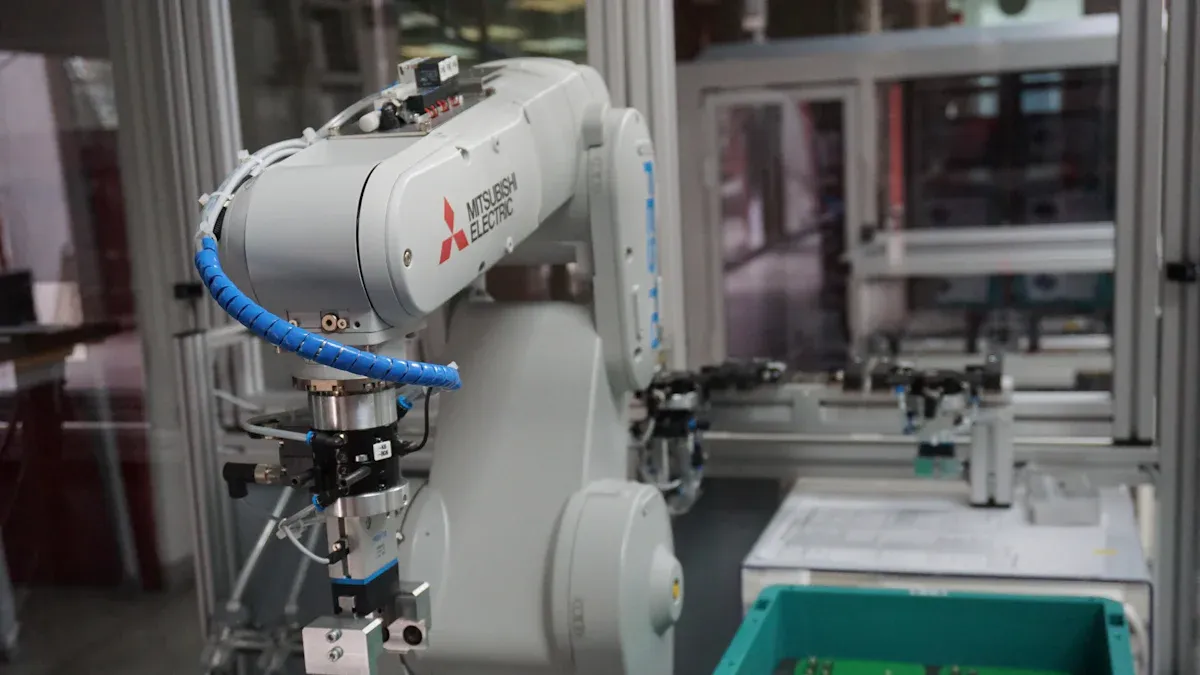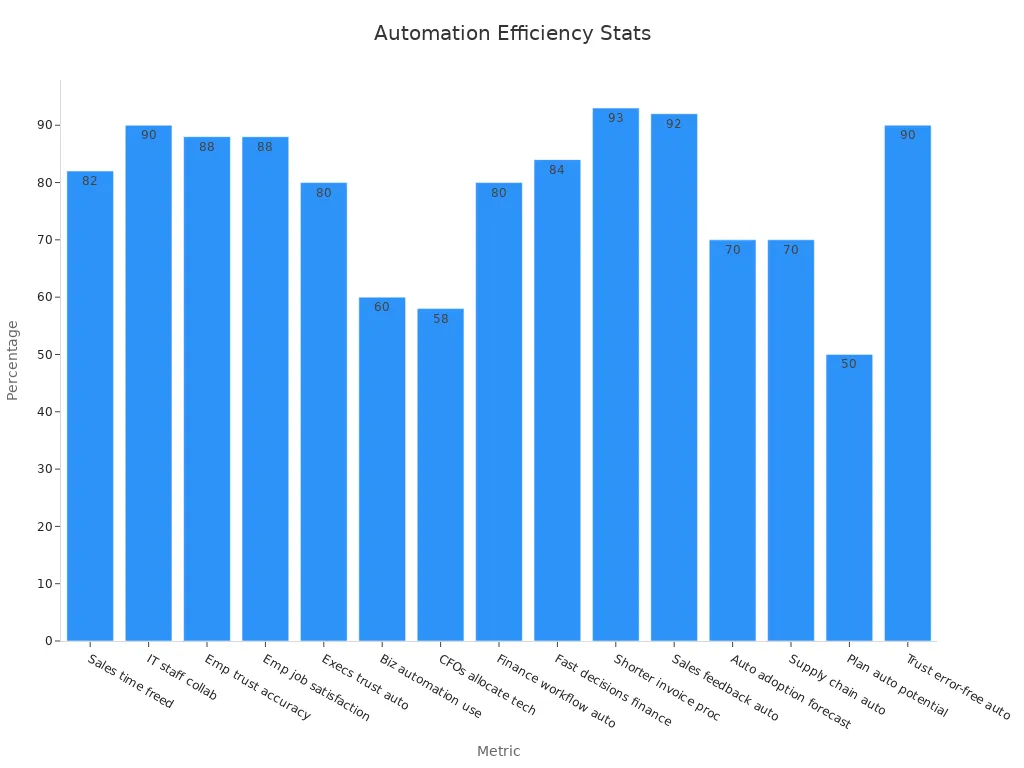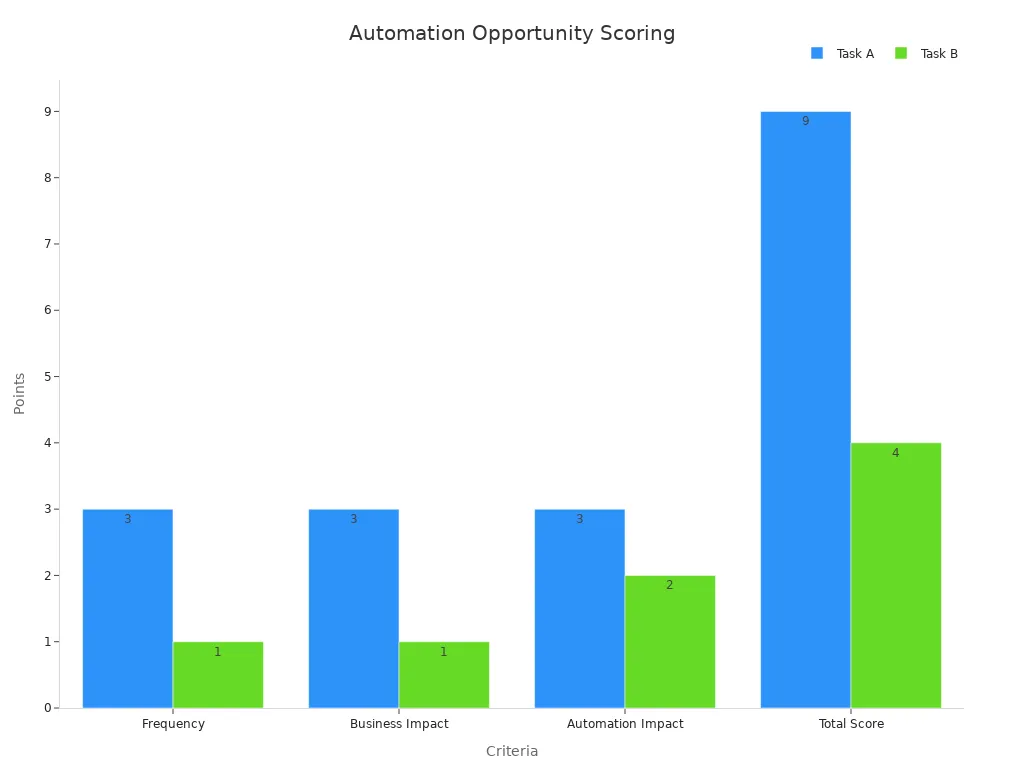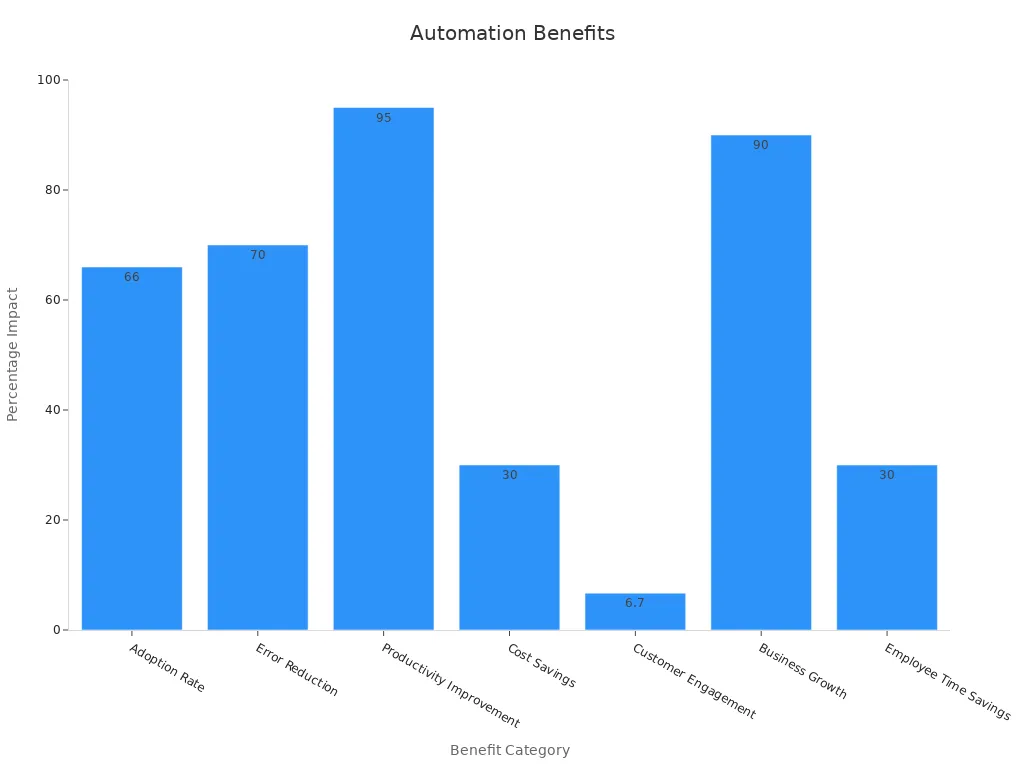Top Practical Methods to Automate Business Processes

Automate business processes to transform your organization by leveraging proven strategies like workflow automation, robotic process automation, and unified platforms. Companies experience significant improvements: Adidas increased operational efficiency by 60%, and a global bank reduced manual work by 35% while boosting customer retention.
Many businesses now automate hiring systems, purchase orders, and budget approvals to reduce costs and accelerate results.
Benefit | Statistic | Description |
|---|---|---|
Time saved (IT leaders) | 73% | Automation cuts manual task time in half |
Cost reduction | Up to 90% | Operational costs decrease dramatically |
Productivity boost | 78% of business leaders | Automation enhances output and focus |
Workflow efficiency | Over 50% of automation tools | Most tools improve process efficiency |

Business management teams also report higher employee morale and faster approvals. Consider which routine process in your business management could benefit most from automating business processes.
Key Takeaways
Start automation by identifying repetitive tasks that slow down your business to save time and reduce costs.
Map workflows visually with flowcharts and involve employees to find delays and improve processes.
Document clear standard operating procedures (SOPs) to ensure consistency and make automation easier.
Prioritize automation projects by focusing on tasks with high frequency, impact, and ease of automation for quick wins.
Choose the right tools like RPA, workflow software, or no-code platforms based on your business needs and scalability.
Test automation with pilot projects and gather user feedback to improve solutions before full implementation.
Monitor key performance indicators regularly to track automation success and make continuous improvements.
Manage change by training teams well, addressing data security, and fostering a culture that embraces automation.
Identify Processes
Identifying the right processes forms the foundation of successful business automation. Companies that start with a clear understanding of their workflows can target the most impactful areas for improvement.
Find Repetitive Tasks
Repetitive tasks often slow down operations and drain resources. These tasks appear in every department, from finance to customer service. By focusing on these activities, organizations can unlock significant efficiency gains.
Department Examples
Finance: Invoice processing, expense approvals, and data entry.
Human Resources: Employee onboarding, leave requests, and payroll updates.
Customer Service: Ticket routing, status updates, and feedback collection.
Sales and Marketing: Lead assignment, campaign tracking, and report generation.
A closer look at operational data shows that automating repetitive tasks can reduce operational costs by 25-50%. For example, robotic process automation (RPA) can handle the workload of two to five full-time employees, freeing staff for higher-value work.
Task Discovery Tools
Modern businesses use specialized tools to uncover repetitive tasks. User activity monitoring software tracks work patterns and highlights tasks that consume the most time. Process mining tools analyze digital footprints to reveal bottlenecks and inefficiencies. These tools help teams focus on tasks that, when automated, deliver the highest return on investment.
Metric | What it Measures | Impact on Efficiency |
|---|---|---|
Time to complete a task | Shorter cycle times mean faster processes | |
Percentage of tasks automated | Higher rates reduce manual work and errors | |
Tasks completed per employee | Reflects the effect of automation on output | |
Work in Progress (WIP) | Number of ongoing tasks | Lower WIP prevents overload and burnout |
Map Workflows
Mapping workflows gives organizations a clear view of how work moves through each process. Visualizing these steps helps teams spot delays, redundancies, and opportunities for automation.
Flowcharts
Flowcharts and swimlane diagrams break down complex processes into simple, visual steps. Human brains process images up to 60,000 times faster than text, making these diagrams powerful tools for quick understanding. For example, a healthcare intake workflow diagram clarifies each stage, improving service delivery and reducing errors. Marketing teams have used workflow visualization to boost campaign registrations by 40% and increase product trials by 20%.
Stakeholder Input
Involving stakeholders ensures that workflow maps reflect real-world practices. Employees who perform daily tasks can point out hidden steps or pain points. Their input leads to more accurate diagrams and better automation outcomes. Visual workflow maps also improve communication, clarify roles, and support training for new team members.
Tip: Honest mapping of current processes, including all exceptions and workarounds, creates a strong foundation for continuous improvement and successful automation.
Document SOPs
Standard operating procedures (SOPs) form the backbone of successful automation. They provide clear, step-by-step instructions for every process, making it easier to automate tasks and maintain high standards across the organization.
Create Standard Procedures
Organizations that standardize and improve their processes before automating see the greatest success. Well-documented SOPs allow automation tools like robotic process automation (RPA) and workflow software to operate more efficiently. Standardization reduces errors, supports compliance, and builds a strong business case for intelligent automation.
Templates
Using templates helps teams document procedures quickly and consistently. Templates ensure that every SOP includes key sections such as purpose, scope, responsibilities, and step-by-step instructions. Many companies use digital SOP templates to speed up documentation and make updates easier.
Tip: Start with a simple template that lists each task, the person responsible, and the expected outcome. This approach makes it easy to spot gaps or overlaps in the process.
Documentation Tips
Clear documentation improves efficiency and quality. Teams should use plain language, avoid jargon, and include visuals like flowcharts or checklists. Regular reviews and updates keep SOPs relevant as processes change. Organizations that document their procedures see measurable improvements:
Fewer errors and less rework
Improved resource utilization and capacity planning
Data-driven decision-making and easier benchmarking
Research shows that automating standardized processes leads to higher consistency, better compliance, and greater operational efficiency.
Ensure Consistency
Consistency in procedures ensures that every employee follows the same steps, no matter who is on duty. This approach reduces errors, increases productivity, and supports reliable automation.
Quality Control
Quality control relies on consistent SOPs. Companies use control charts and statistical process control to monitor production quality in real time. Regular audits and checklists help teams catch mistakes early and prevent repeat defects. For example, Molson Coors reduced lost-time incidents by 33% and cut quality issues in half after implementing consistent SOPs.
Root cause analysis and corrective actions support continuous improvement.
Ongoing training and audits ensure everyone follows the latest procedures.
Customer feedback and data analysis help update quality standards.
Training Materials
SOPs also serve as training materials for new hires and cross-training. Companies like Chipotle require all crew and managers to complete SOP training before starting work, ensuring consistent execution. In industries such as healthcare, manufacturing, and customer service, SOPs standardize onboarding, troubleshooting, and compliance processes.
Organization | Automation Focus | Key Consistent Procedure Aspect | Outcome/Benefit |
|---|---|---|---|
Downer New Zealand | Procurement automation | Predefined rules and digital workflows | |
Aon Ireland | GDPR compliance | Centralized, consistent record-keeping | Avoided compliance challenges with secure data |
Ergo | Customer onboarding | Consistent approach across divisions | Improved customer satisfaction and reduced delays |
SOPs empower employees, reduce training time, and ensure predictable results. This foundation supports scalable automation and continuous improvement across the business.
Prioritize Automation
Prioritizing automation helps organizations focus on the most valuable opportunities first. By using a structured approach, teams can maximize efficiency, reduce costs, and achieve business goals faster.
Assess Impact
Assessing the impact of automation opportunities ensures that resources target processes with the highest potential. Teams should consider several criteria to evaluate each process:
Frequency: How often does the process occur?
Volume: How many transactions or cases does it handle?
Complexity: How many steps or rules are involved?
Variability: Does the process change often?
Impact: How does it affect performance or customer satisfaction?
Feasibility: Is it easy to automate?
Benefits: What are the expected gains, such as time savings or error reduction?
Urgency: How critical is it to automate now?
Risks and Opportunity Costs: What are the challenges or consequences of waiting?
Quick Wins
Quick wins are automation projects that deliver fast results with minimal risk. These projects often involve high-frequency, low-complexity tasks. For example, automating daily sales settlements can save hours each week and improve accuracy. Teams can use a scoring system to compare opportunities:
Criterion | Scoring Scale | Example Task A (Daily Sales Settlement) | Example Task B (Monthly Report Generation) |
|---|---|---|---|
Frequency | 3 = Daily, 2 = 2-3 times/week, 1 = Monthly | 3 points | 1 point |
Business Impact | 3 = Revenue/service critical, 2 = Core support, 1 = Reference | 3 points | 1 point |
Automation Impact | 3 = 70%+ time reduction, 2 = 30-70%, 1 = <30% | 3 points | 2 points |
Total Score | Sum of above | 9 points | 4 points |

A high score signals a strong candidate for quick automation. Teams often start with these projects to build momentum and demonstrate value.
Long-Term Value
Some automation opportunities require more time and resources but offer significant long-term benefits. These projects may involve complex workflows or strategic processes. For example, automating monthly report generation may not save as much time immediately, but it can improve data quality and support better decision-making over time. Organizations should track metrics such as cycle time reduction, error rates, and cost savings to measure the impact of these initiatives. Studies show that over 50% of companies achieve a return on investment from automation within the first year, and productivity can increase by up to 40%.
Build a Roadmap
A clear roadmap guides automation efforts and aligns them with business objectives. Successful roadmaps include detailed plans, timelines, and performance metrics.
Timelines
Automation roadmaps often span several phases. Many organizations start with low-risk projects in the first year, then expand to more complex areas over two to three years. For example:
Year 1: Pilot quick wins and address urgent pain points.
Year 2: Scale automation to core business processes.
Year 3: Optimize and expand to advanced technologies.
This phased approach allows teams to learn, adapt, and build internal expertise. Regular reviews and updates keep the roadmap relevant as business needs evolve.
Business Goals
Aligning automation with business goals ensures that every project supports the organization’s mission. Teams should define clear, measurable objectives for each automation initiative. These might include reducing cycle times, improving customer satisfaction, or increasing productivity. Involving stakeholders from different departments helps identify value drivers and set priorities. Companies like Vonage have unified customer data and streamlined processes through automation, reducing provisioning time from days to minutes and boosting satisfaction.
Tip: Regularly track key performance indicators such as error rates, cost savings, and employee satisfaction to confirm that automation delivers real business value.
A well-prioritized automation strategy leads to higher efficiency, better quality, and sustained business growth.
Automate Business Processes

Selecting the right tools is a critical step for organizations that want to automate business processes effectively. The market offers a wide range of solutions, each with unique strengths. Companies should evaluate these tools based on their business needs, scalability, and ease of use.
Select Tools
RPA
Robotic Process Automation (RPA) uses software robots to handle repetitive digital tasks. RPA works well for processes like data entry, invoice processing, and claims management. Many organizations choose RPA because it can mimic human actions across multiple systems without changing existing infrastructure. RPA also supports integration with artificial intelligence, which helps automate business processes that require decision-making or pattern recognition. For example, healthcare providers have used RPA to reduce manual workload in patient scheduling and claims processing, leading to faster turnaround and cost savings.
Workflow Software
Workflow automation software manages the flow of tasks between people and systems. These platforms help teams design, monitor, and optimize business processes from start to finish. Workflow tools often include features like drag-and-drop builders, notifications, and analytics dashboards. Companies benefit from workflow software by reducing bottlenecks and improving visibility. Comparative studies show that integration with CI/CD pipelines, support for multiple platforms, and strong reporting capabilities set leading workflow tools apart. BrowserStack, for instance, stands out for its cross-browser testing and ease of use.
No-Code Platforms
No-code platforms allow users to automate business processes without writing code. These tools empower non-technical staff to build workflows, create reports, and manage data. The rise of no-code and low-code solutions addresses skills shortages and accelerates digital transformation. Market trends show that AI adoption in automation has grown rapidly, with AI-driven tools enabling faster, more efficient workflows. No-code analytics tools also help teams generate insights and dashboards, fueling business growth.
Tip: When evaluating automation tools, consider factors such as platform support, integration options, reporting features, and user-friendliness. No single tool fits every need, so a combination of specialized solutions may deliver the best results.
Market Trend | Description | Example/Supporting Data |
|---|---|---|
AI and Machine Learning Integration | Reduces complexity and improves automation efficiency | TestGrid's AI-based platform enables multi-format test case creation (June 2023) |
Rapid Market Growth | Automation market expected to reach $59.91B by 2029 (19.6% CAGR) | Driven by software complexity and faster time-to-market needs |
Digitalization and Automation | Shift from manual to automated processes | 97% of global companies accelerated automation adoption (World Economic Forum, 2022) |
Emerging Technologies | Blockchain, IoT, 5G, cloud, AI push automation boundaries | Industry leaders like Accenture and IBM drive innovation |
Implement Solutions
Pilot Projects
Organizations often start with pilot projects to test automation tools in a controlled environment. These pilots help teams measure outcomes, identify challenges, and refine processes before scaling up. Successful pilot projects in healthcare, customer service, and IT have led to reduced processing times, cost savings, and improved employee satisfaction. Key performance indicators include cost savings, error rate reduction, and increased throughput.
User Feedback
Collecting user feedback during pilot projects ensures that automation solutions meet real-world needs. Employees can highlight usability issues, suggest improvements, and report on productivity gains. This feedback helps organizations fine-tune their approach and increase adoption rates. Companies that automate business processes with user input see higher satisfaction and better long-term results.
Note: Pilot projects that align with business goals and include clear metrics provide a strong foundation for scaling automation across the organization.
Monitor and Optimize

Automation does not end after implementation. Companies must monitor performance and optimize processes to achieve lasting results. This approach ensures that automation continues to deliver value as business needs evolve.
Track Performance
Tracking performance helps organizations understand if automation meets goals. Regular measurement allows teams to spot issues early and make improvements.
KPIs
Key performance indicators (KPIs) provide clear targets for automation success. Companies track both technical and business outcomes to ensure a balanced view. Common KPIs include system uptime, routing efficiency, and conversion rates. These metrics help teams respond quickly to problems and maintain high standards.
KPI | Target | Frequency of Measurement |
|---|---|---|
System uptime | 99.9% | Daily |
Routing efficiency | 95% | Weekly |
Conversion rates | 20% increase | Monthly |
Other important KPIs measure data entry efficiency, error rate reduction, and real-time reporting speed. For example, tracking the time saved in processes before and after automation shows direct benefits. Monitoring employee productivity and user adoption rates also highlights how automation impacts daily work.
Tip: Real-time monitoring and automated alerts based on KPIs help teams act fast and keep automation running smoothly.
Continuous Improvement
Continuous improvement keeps automation relevant and effective. Teams review KPIs regularly and use feedback to refine workflows. They look for patterns in errors or delays and adjust processes to remove bottlenecks. Companies also use statistical tools to check if changes lead to real improvements. For example, analyzing error rates and customer satisfaction scores helps teams focus on areas with the most impact.
Regular reviews ensure automation aligns with business goals.
Feedback from employees and customers guides updates.
Data analysis supports smarter decisions and better results.
Scale Automation
Scaling automation expands its benefits across the organization. Companies start with one area, then move to new departments or processes as they gain experience.
Expand to New Areas
Many businesses grow automation by targeting new functions. Manufacturing firms have improved product quality and increased output by automating production and inventory tasks. Retailers and e-commerce companies automate order processing and customer communication, which boosts accuracy and satisfaction. Service industries use automated scheduling to reduce administrative work and improve client experiences.
Automation helps small businesses scale without large overhead.
Customizing automation for each area supports business growth.
Ongoing training and analytics keep workflows aligned with goals.
Advanced Technologies
Advanced technologies like artificial intelligence, machine learning, and cloud platforms push automation further. Companies use these tools to handle complex tasks, predict trends, and personalize customer experiences. For example, global firms integrate automation across departments, allowing staff to focus on higher-value work. Regular updates and new technology adoption ensure automation stays effective as the business grows.
Note: Automation works best as an evolving process. Teams should combine machines, people, and data to drive continuous improvement and long-term success.
Manage Change
Change management plays a crucial role in successful business process automation. Companies that manage change well see higher adoption rates, better team performance, and fewer disruptions.
Train Teams
Training ensures employees can work confidently with new automated systems. Well-prepared teams adapt faster and make fewer mistakes.
Onboarding
Effective onboarding programs introduce employees to new tools and workflows. Digital Learning Management Systems (LMS) help speed up onboarding by providing accessible, up-to-date training materials. In 2021, 88% of small and medium businesses reported that automation helped them compete with larger companies by enabling faster operations. LMS platforms allow employees to learn at their own pace and revisit materials as needed. This approach ensures everyone understands how to use automated systems from day one.
Leadership training also matters. Programs that focus on trust, accountability, and virtual communication improve team performance in automated environments. Research shows that 87% of high-performing companies use project management systems, highlighting the value of technology integration in leadership development.
Support Resources
Ongoing support keeps teams engaged and confident. Companies provide resources such as help desks, user guides, and peer mentoring. Automated learning technologies enable continuous upskilling, helping employees adapt to changes and new features. Case studies from companies like Toyota and Procter & Gamble show that structured training and incentive programs lead to measurable improvements in team engagement, system performance, and cost efficiency. For example, Toyota’s Automation Excellence Program reduced unplanned downtime by 23% and improved knowledge sharing by 67% over three years.
Tip: Regular feedback sessions and performance dashboards help identify skill gaps and guide future training efforts.
Address Challenges
Automation brings new challenges, especially around data security and workplace culture. Addressing these issues early supports smoother transitions and long-term success.
Data Security
Protecting data is essential in automated environments. Automation strengthens security by enabling continuous asset discovery, automated risk assessment, and real-time compliance monitoring. Companies use automated incident response workflows to reduce response times and improve coordination. Automated reporting and analytics save time and provide actionable insights, allowing security teams to focus on strategic tasks.
Automation also ensures consistent regulatory compliance and minimizes human error. Automated data classification and encryption protect sensitive information, while threat detection tools accelerate risk assessment. Data Loss Prevention (DLP) automation monitors data sharing and prevents leaks. These measures lead to faster response times, reduced errors, and greater cost efficiency.
Culture Shift
Adopting automation often requires a shift in workplace culture. Employees may worry about job changes or feel uncertain about new technologies. Effective change management addresses these concerns through leadership involvement, open communication, and feedback loops. Companies that engage employees and provide clear information see higher adoption rates. Automation adoption grows significantly with strong change management, as shown by a 14% annual increase in automated jobs and two-thirds of knowledge workers reporting improved productivity.
Change management software with AI and analytics helps organizations track adoption, predict resistance, and personalize support. Case studies show that these practices reduce change fatigue, speed up adoption, and improve stakeholder engagement.
Note: Building a culture that values learning and innovation helps teams embrace automation and drive continuous improvement.
Automating business processes brings clear advantages. Companies see fewer errors, higher productivity, and lower costs. The table below highlights these benefits:
Benefit Category | Statistic / Impact |
|---|---|
Error Reduction | |
Productivity Improvement | 95% of IT professionals report increased productivity |
Cost Savings | 30% reduction in cost-per-hire |
Business Growth | Nearly 90% report growth due to automation |

These methods make it practical for any team to automate business processes. Starting with one process helps build momentum. Regular reviews and updates keep automation effective as technology changes.
FAQ
What is business process automation?
Business process automation uses technology to complete routine tasks. Companies use it to save time, reduce errors, and improve efficiency. Automation tools handle repetitive work so employees can focus on more important activities.
Which business processes are best to automate first?
Teams should start with repetitive, rule-based tasks. Examples include invoice processing, data entry, and employee onboarding. These tasks often show quick results and help build confidence in automation.
How does automation impact employee roles?
Automation removes manual work from employees. Workers can then focus on creative, problem-solving, or customer-facing tasks. Many companies report higher job satisfaction after automation.
What tools help automate business processes?
Popular tools include robotic process automation (RPA), workflow management software, and no-code platforms. Each tool fits different needs. Teams should choose based on process type, scalability, and ease of use.
Is automation expensive to implement?
Costs vary by project size and tool choice. Many companies see a return on investment within the first year. Cloud-based and no-code solutions often lower upfront costs.
How can a company measure automation success?
Teams track key performance indicators (KPIs) like time saved, error reduction, and cost savings. Regular reviews help ensure automation meets business goals.
What are common challenges in automation projects?
Challenges include employee resistance, data security concerns, and unclear processes. Training, clear communication, and strong leadership help overcome these issues.
Can small businesses benefit from automation?
Small businesses gain from automation by saving time and reducing costs. Many affordable tools exist for smaller teams. Automation helps small companies compete with larger organizations.



